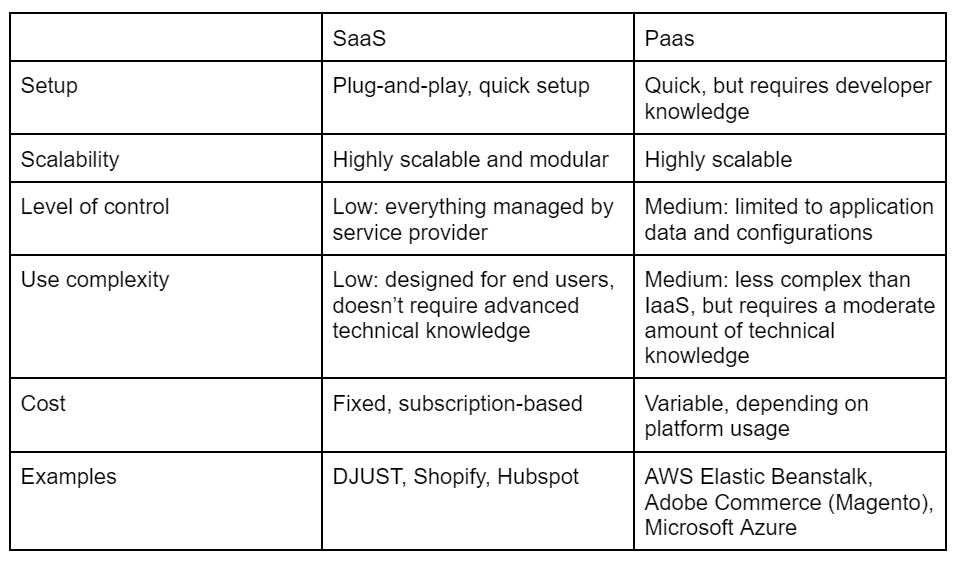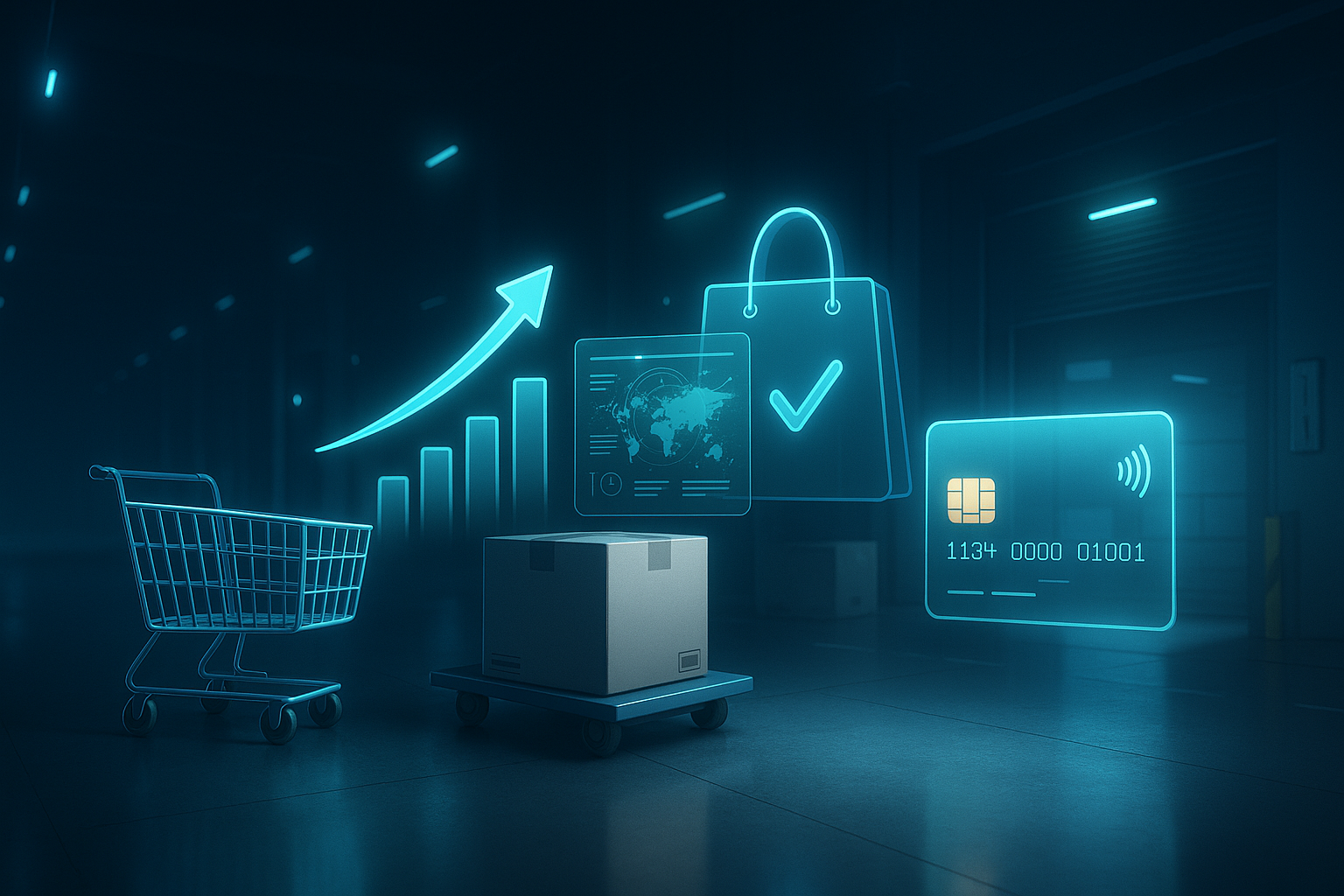

Cloud computing services have grown immensely since their inception. According to Statista, the market was worth $145 billion in 2017, but that number has jumped to $573 billion in 2023, with a projected value of $678 billion in 2024. Among the variety of cloud services available today, software as a service (SaaS) and platform as a service (PaaS) are two of the most popular options for B2B eCommerce platforms.
Before launching your new eCommerce site, you must decide between SaaS and PaaS. Your choice will impact your business’s sales and growth, so you want to make sure you go with the best fit for your situation. While this may be a complicated decision, DJUST is here to help you determine the best solution for your B2B eCommerce strategy.
Short on time? Here are the key takeaways
Before we dive into the details, let’s take a brief look at the key differences between SaaS and PaaS solutions.
- Both SaaS and PaaS solutions allow for quick setup, but PaaS requires developer knowledge to set up and implement.
- Both SaaS and Paas are highly scalable, but PaaS solutions are typically built for scalable application development.
- With SaaS platforms, the application is largely managed by the service provider, but with PaaS you have a bit more control over application and data. However, the service provider still holds the majority of control over infrastructure and operating systems.

SaaS: Software as a service
Software as a service (SaaS) is a cloud-based solution that provides ready-to-use software that is managed by a third-party service provider. Infrastructure and application management are handled by the provider, and the software is accessible to you solely via the internet. SaaS solutions are perfect for B2B eCommerce platforms looking for fully managed solutions that are user friendly, quick to implement, and don’t require advanced technical knowledge by many members of the team.
Key characteristics
SaaS products are accessible from any device with internet access and a web browser, with the exception of mobile devices. While there are some available mobile apps, you will typically need computer access. The client only needs to log in from a compatible device using valid credentials. The vendor owns and operates all the infrastructure necessary to run your eCommerce site, and they handle issues ranging from bugs to errors to security concerns.
SaaS platforms typically offer their products through fixed, monthly subscription-based billing. Customers aren’t required to pay for licenses or upgrades unless they want a higher-tiered plan than the one they’re currently paying for.
SaaS products support single sign-on capabilities to ensure data security and privacy. This allows individual staff to sign in to various applications using only one set of credentials.
Advantages
Building a new B2B eCommerce site can be daunting, but with SaaS, it doesn’t have to be. Set up and implementation is quick and easy since many SaaS platforms configure quickly. With DJUST, your eCommerce platform can be up and running within four months. Since SaaS solutions are designed for the end user and the provider handles the technical infrastructure, you don’t have to be a technical expert to manage and update your eCommerce site.
Also, your staff will get personalized login credentials to match their access level. All they have to do to access the software is hop onto their web browser and log in. Your IT staff won’t have to worry about downloading and updating software across computers in your office.
With SaaS, scalability is no problem. Should your business experience rapid growth and you require more storage or advanced features, you only have to upgrade your service for more storage and bandwidth. The provider will handle everything for you, so there’s no risk of encountering infrastructure limitations. As customer traffic increases, your provider will automatically adjust their IT infrastructure so that there won’t be any overpowered servers, which is great for sustainable eCommerce.
Limitations
While convenient and a great option for eCommerce platforms, you don’t have as much control with a SaaS solution. Choosing a SaaS provider means you hand over the keys to functionality, performance, and your sensitive data. You want to be sure that you trust the provider before signing on with them.
In terms of security, the provider is responsible for safeguarding your sensitive company and customer data and credentials. If the vendor isn’t reputable or experiences a breach, your company’s data privacy can be compromised. However, reputable providers have strong security measures that include data encryption and 24/7 monitoring. In the unfortunate event of a cyberattack, providers will have detailed recovery plans to help, and you can be secure in the knowledge that the provider automatically backs up all of your data.
While smaller SaaS solutions lack a wide range of integrations, this is not the case with DJUST. Most of our software is highly customizable, and we have a sophisticated integration process that supports custom integrations for B2B construction and B2B retail.
Examples of SaaS solutions
SaaS products can take many forms. While also an enterprise platform, DJUST is a top example of a sophisticated SaaS solution. Our dynamic software lets you create your ideal eCommerce platform. Other well-known examples of eCommerce SaaS platforms include Salesforce, BigCommerce, Hubspot, MailChimp, OpenCart, and Squarespace, and Google Workspace is an example of a non-eCommerce SaaS.
What it all means in the context of eCommerce
SaaS is the best choice for B2B eCommerce due to its flexibility and scalability. As your sales grow and you reach new markets, add-on modules give you access to more advanced features, such as more robust customer, catalog, and order management features. Plus, you can modify your customer interface and order workflows, create different product catalogs for different markets, and more from anywhere, as long as you have reliable internet access.
SaaS solutions provide you with the tools and analytics to help you run your eCommerce site efficiently and effectively. Platforms like DJUST provide you with back-end dashboards that allow you to monitor and manage your growing sales and other data. With these dashboards, you can easily manage inventory, accept payments, review key performance indicators (KPIs), track supplies and orders, track customer data, and much more.
Expert advice: Keep in mind that there are many “fake SaaS” solutions out there. These companies are merely on-premise, cloud-based platforms that are not fully SaaS.
PaaS: Platform as a service
Platform as a service (PaaS) gives developers a framework and the tools necessary to build apps and software via the internet. A scaled-down version of infrastructure as a service (IaaS), PaaS allows its customers access to servers, storage, and networking. However, the third-party provider still owns all of these resources and rents them out to clients. A business pays a specific amount to gain access to as many resources as needed.
Key characteristics
It helps to divide PaaS products into three parts: the cloud infrastructure, software, and the graphic user interface (GUI). The cloud infrastructure includes virtual machines, cloud storage, access to physical servers, and more. Software encapsulates operating systems, software development kits (SDKs), and libraries. GUI is for developers to work on the backend.
PaaS products are designed for businesses to create and test unique applications and software. These solutions allow you to experiment with new technologies without a large investment in infrastructure.
Similar to SaaS, PaaS is cloud-based and can be accessed from anywhere. Team members can also collaborate with each other simultaneously while working from anywhere.
Advantages
Compared to on-site infrastructure, PaaS solutions are much cheaper, as you only pay for what you need. If your developers need more tools or storage, you can upgrade as necessary. If you plan correctly, there are no wasted expenses.
PaaS benefits developers significantly, as they don’t have to take on the responsibility of setting up a new infrastructure. Instead, they can all share the same tools no matter where they are. This helps further save money and time required for growth.
If you’re experiencing a high-traffic period, scaling up is simple and easy. You can always scale back if traffic takes a dive. PaaS’s flexibility in this regard is also tied to its low maintenance on the client’s side. The provider is responsible for the hardware’s operability and maintenance.
Limitations
While we have addressed some of the advantages of PaaS, know that there are some considerable disadvantages to be aware of, especially for firms that are smaller or growing. The most significant limitation of a PaaS solution is that PaaS requires a certain amount of developer and IT knowledge. While SaaS can be run by pretty much anyone regardless of expertise, with PaaS, an IT team must be available for maintenance (at the very least).
In addition, with PaaS you can only control what’s built on the platform. Customized cloud operations might not be compatible with your provider, which might lead to a limit in scope of your eCommerce business.
Some PaaS solutions may not be optimized for the specific programming language your business uses. This can hinder the development of any of your applications, and you might find that you will have to adapt to the programming language of your provider. If your PaaS decides to change programming language, you will be forced to change language again.
When you choose a PaaS, you are committing to a long-term relationship with your provider. Provider lock-in can lead to a difficult transition if you want to swap to another PaaS provider or cloud-based model since you are dependent on the infrastructure, software, and in some cases programming language of your current PaaS provider. Additionally, your ongoing projects might be compromised by any breakdowns or significant updates to your chosen PaaS.
Examples of PaaS solutions
Popular examples of a PaaS are Microsoft Azure and AWS Elastic Beanstalk. Adobe Commerce (Magento) and Heroku are examples of an eCommerce PaaS.
What it all means in the context of eCommerce
PaaS can be an important part of your solid eCommerce business plan, and these solutions are suitable for enterprise businesses interested in developing a customized platform for their consumers. With PaaS, you don’t need to worry about the operating system or the system software, and you are provided with a platform where you can set up your own eCommerce site. PaaS allows you access to the code of your eCommerce site, and you will be able to upload and configure content, products, and your custom code, as well as manage databases.
The bottom line
Deciding between SaaS and PaaS solutions comes down to the type of services a business needs and its eCommerce goals. PaaS is ideal for developers who want to build applications without worrying about the underlying infrastructure, while SaaS is the best solution for B2B eCommerce due to its flexibility and sustainability.

-modified.avif)



